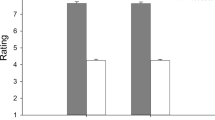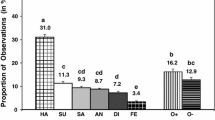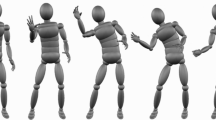Abstract
The present paper explores the validity of 16 facial movements (e.g., eyelid widening, lips part) and two psychophysiological responses (e.g., heart rate) as interest-associated behaviors. In a pilot study we selected interesting and uninteresting stimuli, and in two experiments we asked undergraduate volunteers to watch and listen to a series of 4-min film clips and self-report their level of interest. As each participant viewed the films, we videotaped, coded, and scored his or her facial movements and recorded the autonomic responses. Using repeated-measure ANOVAs and correlational analyses, we found support for five upper facial behaviors (eyes closed, number of eye glances, duration of eye glances, eyelid widening, exposed eyeball surface), one lower facial behavior (lips part), and two general head movements (head turns, head stillness) as interest-associated facial movements. The discussion focuses on how these findings confirm, contradict, and clarify the observations of others (e.g., Darwin, Tomkins, Izard).
Similar content being viewed by others
References
Berlyne, D. E. (1966). Curiosity and exploration.Science, 153 25–33.
Berlyne, D. E., Craw, M. A., Salapatek, P. H., & Lewis, J. L. (1963). Novelty, complexity, incongruity, extrinsic motivation, and the GSR.Journal of Experimental Psychology, 66 560–567.
Bernstein, A. S., Taylor, K. W., & Weinstein, E. (1975). The phasic electrodermal response as a differentiated complex reflecting stimulus significance.Psychophysiology, 12 158–169.
Cacioppo, J. T., Petty, R. E., Losch, M. E., & Kim, H. S. (1986). Electromyographic activity over facial muscle regions can differentiate the valence and intensity of affective reactions.Journal of Personality and Social Psychology, 50 260–268.
Cohen, B. H., Davidson, R. J., Senulis, J. A., Saron, C. D., & Weisman, D. R. (1991).Muscle tension patterns associated with auditory attention. Unpublished manuscript, New York University.
Darwin, C. (1872).The expression of emotions in man and animals. London: John Murray.
Ekman, P. (1985).Telling lies: Clues to deceit in the marketplace, politics, and marriage. New York: Norton.
Ekman, P., Friesen, W. V. (1975).Unmasking the face: A guide to recognizing emotions from facial clues. Englewood Cliffs, NJ: Prentice-Hall.
Ekman, P., & Friesen, W. V. (1978).Facial Action Coding System: A technique for the measurement of facial movement. Palo Alto: Consulting Psychologists Press.
Ekman, P., & Friesen, W. V. (1986). A new pan-cultural facial expression of emotion.Motivation and Emotion, 10 159–168.
Ekman, P., & Friesen, W. V. (1988). Who knows what about contempt: A reply to Izard and Haynes.Motivation and Emotion, 12 17–22.
Ekman, P., & Friesen, W. V., & Ellsworth, P. (1982). What emotion categories or dimensions can observers judge from facial behavior? In P. Ekman (Ed.),Emotion in the human face (pp. 30–55). New York: Cambridge University Press.
Ekman, P., & Oster, H. (1979). Facial expressions of emotion.Annual Review of Psychology, 30 527–554.
Fowles, D. C. (1983). Motivational effects of heart rate and electrodermal activity: Implications for research on personality and psychopathology.Journal of Research in Personality, 17 48–71.
Haagh, S. A. V. M., & Brunia, C. H. M. (1984). Cardiac-somatic coupling during the foreperiod in a simple reaction-time task.Psychological Research, 46 3–13.
Hass, H. (1970).The human animal. New York: Putman's Sons.
Izard, C. E. (1971).The face of emotion. New York: Appleton-Century-Crofts.
Izard, C. E. (1977).Human emotions. New York: Plenum Press.
Izard, C. E. (1990).The psychology of emotion. New York: Plenum Press.
Izard, C. E., Dougherty, F. E., Bloxom, B. M., & Kotsch, W. E. (1974).The differential emotions scale: A method of measuring the subjective experience of discrete emotions. Unpublished manuscript, Vanderbilt University.
Izard, C. E., & Haynes, O. M. (1988). On the form and universality of the contempt expression: A challenge to Ekman and Friesen's claim of discovery.Motivation and Emotion, 12 1–16.
Langsdorff, P., Izard, C. E., Rayias, M., & Hembree, E. (1983). Interest expression, visual fixation, and heart rate changes in 2- to 8-month old infants.Developmental Psychology, 19 375–386.
Mehler, B., Miller, L., Antonucci, P., Cochran, P. (1986).Biofeedback microlab. Pleasantville, NY: Human Relations Media.
Reeve, J. (1989). The interest-enjoyment distinction in intrinsic motivation.Motivation and Emotion, 13 83–103.
Reeve, J. (1991).Discriminations in the expressions of the interest and joy emotions. Paper presented at the annual conference of the Eastern Psychological Association, New York.
Rinn, W. E. (1984). The neuropsychology of facial expression: A review of the neurological and psychological mechanisms for producing facial expressions.Psychological Bulletin, 95 52–77.
Tabachnick, B. G., & Fidell, L. S. (1989).Using multivariate statistics (2nd ed.). New York: Harper & Row.
Tomkins, S. S. (1962).Affect, imagery, and consciousness. New York: Springer.
Tomkins, S. S. (1980). Affect as amplification: Some modifications in theory. In R. Plutchik & H. Kellerman (Eds.),Emotion: Theory, research, and experience (Vol. 1, pp. 141–164). New York: Academic Press.
Tsubota, K., & Nakamori, K. (1993). Dry eyes and video display terminals.New England Journal of Medicine, 328 584.
Zillman, D. (1980). Anatomy of suspense. In P. H. Tannenbaum (Ed.),The entertainment functions of television (pp. 133–163). Hillsdale, NJ: Erlbaum.
Author information
Authors and Affiliations
Additional information
I wish to extend my gratitude to the codirectors of the Center for Research on the Effects of Television (CRETV), Cyndy Schiebe of Ithaca College and John Condry of Cornell University, for allowing me use of videotapes from the CRETV archives that served as experimental stimuli in the present set of studies. I also extend my gratitude to associate editor Condry, Glen Nix, Ed Deci, and two anonymous reviewers for their insightful and constructive comments on an earlier version of the manuscript.
Rights and permissions
About this article
Cite this article
Reeve, J. The face of interest. Motiv Emot 17, 353–375 (1993). https://doi.org/10.1007/BF00992325
Issue Date:
DOI: https://doi.org/10.1007/BF00992325




